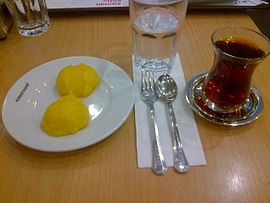This is an old revision of this page, as edited by Tom.Reding (talk | contribs) at 21:29, 13 February 2018 (Fix Category:Pages using deprecated image syntax; WP:GenFixes on, using AWB). The present address (URL) is a permanent link to this revision, which may differ significantly from the current revision.
Revision as of 21:29, 13 February 2018 by Tom.Reding (talk | contribs) (Fix Category:Pages using deprecated image syntax; WP:GenFixes on, using AWB)(diff) ← Previous revision | Latest revision (diff) | Newer revision → (diff) Hoşmerim and Turkish tea Hoşmerim and Turkish tea | |
| Course | Dessert |
|---|---|
| Place of origin | |
| Main ingredients | Semolina, cheese, sugar, milk, almond |
Höşmerim is a popular delicacy which is extensively manufactured in the Aegean, Marmara, Trakya and Central Anatolia regions of Turkey, and is presented with different names such as Hosmelim or cheese halva. It is generally consumed after a meal as a light dessert alone or combined with ice cream, honey or nuts.
Höşmerim has been served for 50–55 years as a commercial product in the markets and pastry shops. However, most of its manufacture occurs in a small scale with the recipes and methods differing from one region to another. Traditional recipes include fresh unsalted cheese particularly from ovine milk, semolina and powdered sugar, however, for commercial production, cream, egg and riboflavin are included in the recipe with the traditional ingredients.
Etymology
According to the folk etymology, a soldier could not see his wife for a long time because of the war. When the war finished, man came to his village and saw his wife. His wife prepared Hoşmerim and asked her husband "Hoş mu erim?" meaning "Is it nice, my man?"
In reality, it comes from Persian xoş (sweet) + maram (kaymak).